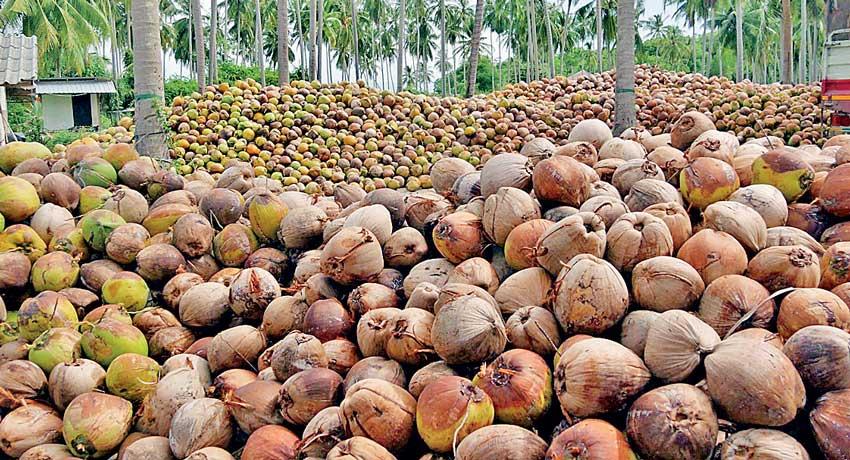06 Apr 2021 - {{hitsCtrl.values.hits}}

COVID’s full impact on the Sri Lankan economy is yet to be felt. However, it is clear that the impact of the outbreak may already being felt. For instance, the export sector, critical to the economy, is now bracing for impact.
The apparel sector, which represents 47 percent of Sri Lanka’s exports, is one such sector that is facing COVID’s pressure. In a backdrop of such deterioration, the importance of Sri Lanka’s agro-products cannot be overstated.
This sector has a major role to play. Its importance is managed by its constituent crops. Among prominent agro-produce are tea, rubber, coconuts and paddy. Everyone knows the powerful connection that Sri Lankan society has with paddy farming. Paddy has been the agro-backbone of Sri Lanka, of equal importance is the humble coconut. According to the Coconut Growers Association of Sri Lanka (CGASL), paddy and coconut are the mainstays of rural economy.
Part of Sri Lankan life for centuries
The humble coconut has significantly been a part of Sri Lankan life for centuries due to its close intimacy to the day-to-day lives of the people. The wholesomeness of coconuts has forever been a totem in the lives of our social strata.
For centuries, the palm-fringed island of Sri Lanka has been welcoming travellers of both East and West and often their first welcome invitation from the shores had –and has been from a coconut tree’s alluring crown.
Sri Lanka is the fourth largest coconut producer in world’s annual US $36 billion industry. Experts say that when it comes to Sri Lankan tree crops, coconut generates the highest per annum income compared to rubber and tea -the other two traditional tree crops. Coconut generates Rs. 175,000 per hectare per annum, while tea and rubber produce Rs. 45,000 and Rs. 50,000 structural equation model brand equity.
Even though around 2,500 small and medium-scale mills produce coconut oil in Sri Lanka it is reported that only a few large industries are involved in it. According to the Coconut Development Authority (CDA) currently the coconut cultivation in Sri Lanka is a little over one million hectares.
The area under rubber cultivation is lower-at 126,700 ha (2018). While coconut has such an iconic presence in the Sri Lankan socio-economic yore, the outlook of this tree crop is not so promising in the medium to long run.
Coconut production
Despite medium term coconut production trend (of 2010-’19) is on an upward trend, one cannot ignore the uncontrollable in-between fluctuations of annual coconut production levels.
The Rs. 2.9 billion nut production in 2012 fell to 2.5 billion in 2013 which then peaked to 3.05 billion which, thereafter declined to 2.45 billion. The production then peaked again to Rs. 3 billion in 2019. According to the existing demand for coconuts in Sri Lanka, the coconut industry here requires around 3.6 billion nuts but the level of production is only between 2.5- 2.8 billion.
According to Coconut Research Institute, the sector provides livelihoods to around 700,000 and employment to 135,000. This is twice the rate of that of the apparel sector. The fall of coconut sector therefore is likely to create ripple effects across the socio-economic fabric exceeding that of even apparel sector.
There are reams and reams of data on Sri Lankan coconut sector which can be endlessly reproduced here but the foregoing data alone are indicative of the danger of coconut’s forfeiture from its ‘Tree Crops’ glory.
Coconut-based industrial system
Sri Lanka briefly woke up to the grim reality of the coconut’s plight in 2020 when it produced no less than a Cabinet paper. On 22 December 2020 the Cabinet approved a set of proposals presented by the Minister of Plantation and the Minister of industry for the development of the coconut-based industrial system.
Among the proposals were a complete prohibition on the sale of coconut oil mixed with palm oil or other oils to protect consumer rights and the brand name of the Sri Lankan coconut oil, recognition of the discouragement of palm oil consumption in the country and promotion of coconut oil as a basic policy of the government and permission to import only refined palm oil, concerning consumer rights and public health reasons, to provide relief to repay the loans obtained by the coconut industrials, the introduction of relief packages to increase the productivity of coconut plantations such as intercropping, dairy farming, and irrigation to encourage coconut cultivation.
This is a welcome step in the right direction. Still, it is not the ‘only step’ in that direction. The setback in the apparel sector due to the pandemic has led to the dawn of a new realization that it is time that wellsprings such as Tree Crops to come to the fore and save Sri Lanka’s export sector and its livelihoods-led by the humble coconut.
All stakeholders in the industry can join in the launch of this critical first step. Still, the central mobiliser here will be the engagement of state officials which can positively accelerate the process-and clinch this rare window of opportunity for Sri Lanka’s coconut industry.
23 Dec 2024 8 hours ago
23 Dec 2024 9 hours ago
23 Dec 2024 23 Dec 2024
23 Dec 2024 23 Dec 2024